You’ll transform your kitchen into a lush, functional space by strategically incorporating plants into your existing decor. Whether you’re working with a compact galley kitchen or a spacious open layout, there’s a plant-based solution that fits your needs. From creating a practical herb garden within arm’s reach of your cooking area to installing dramatic vertical displays that maximize corner spaces, these ten design approaches will help you merge natural elements with your culinary workspace. Let’s explore how each technique can enhance both the aesthetics and functionality of your kitchen environment.
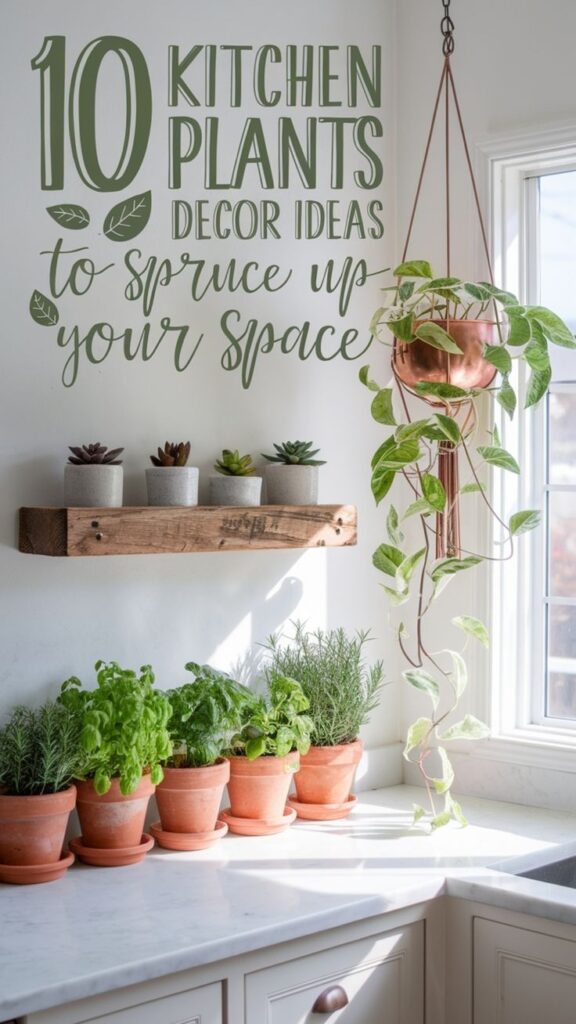
Contents
- 1 Creating a Kitchen Herb Garden Window Display
- 2 Hanging Plants From Ceiling-Mounted Planters
- 3 Utilizing Corner Spaces With Vertical Plant Stands
- 4 Styling Your Kitchen Island With Potted Greenery
- 5 Incorporating Trailing Plants on Open Shelving
- 6 Maximizing Counter Space With Mini Succulent Gardens
- 7 Installing Living Wall Planters for Fresh Herbs
- 8 Decorating Above Cabinets With Low-Maintenance Plants
- 9 Setting up a Kitchen Windowsill Garden
- 10 Adding Plant-Filled Floating Shelves Above the Sink
Creating a Kitchen Herb Garden Window Display
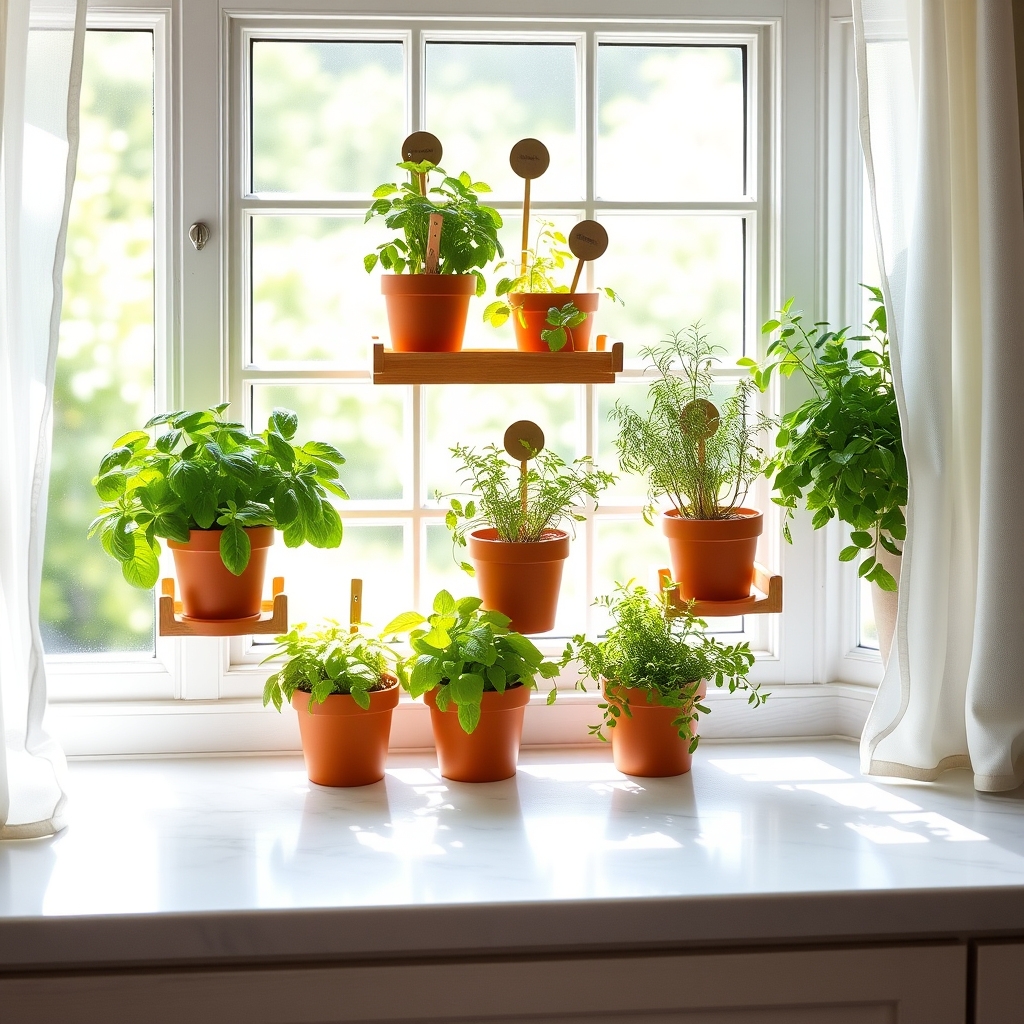
A kitchen herb garden window display transforms an ordinary kitchen window into a functional growing space and decorative focal point. Fresh herbs are arranged in tiered planters, window boxes, or individual pots along the windowsill, maximizing natural sunlight exposure.
The display typically features popular cooking herbs like basil, thyme, rosemary, and mint in coordinated containers that complement the kitchen’s style. Small plant markers or decorative labels identify each herb, while the varying heights and textures of the plants create visual interest.
The setup allows easy access for cooking while providing a living green element that enhances the kitchen’s aesthetic. Window-mounted shelving or hanging systems can expand the growing space vertically, accommodating more plants without cluttering the counter space below.
Hanging Plants From Ceiling-Mounted Planters
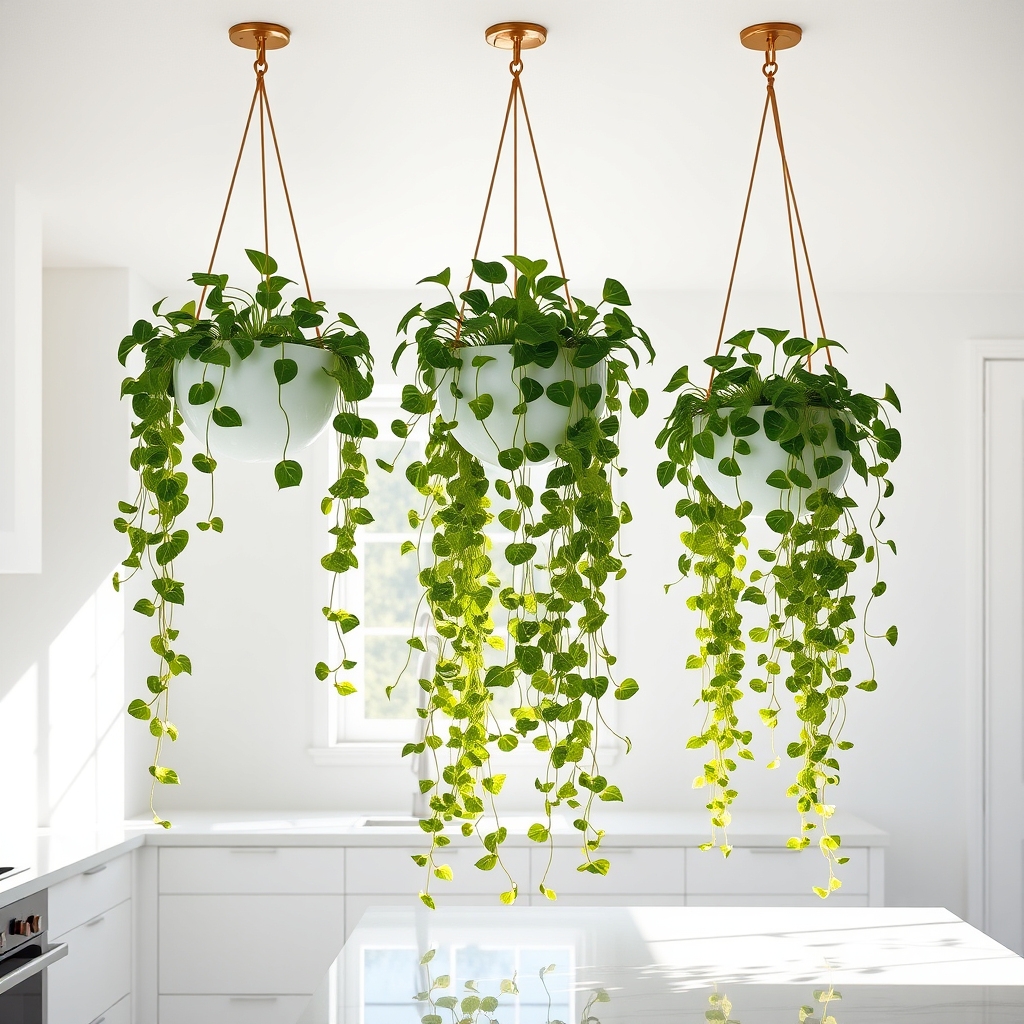
Ceiling-mounted planters offer an elegant way to display hanging plants in the kitchen without occupying counter or floor space.
These installations typically consist of sturdy hooks, decorative brackets, or suspended railings anchored securely to the ceiling joists. Plants cascade downward, creating natural curtains of foliage that add vertical interest and soften the kitchen’s hard surfaces.
Common choices include pothos, spider plants, and string of pearls, which thrive in hanging positions and produce trailing vines.
The planters themselves come in various materials like ceramic, metal, or macramé, allowing them to complement different kitchen styles from modern to bohemian.
Strategic placement over kitchen islands or in corners maximizes impact while keeping plants safely away from cooking areas and heat sources.
Utilizing Corner Spaces With Vertical Plant Stands

Vertical plant stands designed for corner spaces transform underutilized areas into eye-catching displays of greenery.
These stands typically feature multiple tiers arranged in a triangular or quarter-circle shape that fits snugly into room corners. The structure usually consists of metal, wood, or bamboo frames with graduated shelves that ascend upward, allowing plants to be displayed at various heights.
The unique feature of corner vertical plant stands lies in their space-efficient design, maximizing vertical real estate while maintaining a small footprint.
These stands often incorporate adjustable shelving to accommodate different plant sizes and can hold anywhere from 3 to 8 plants depending on the design. Some models include features like drip trays, rotating platforms, or built-in grow lights to enhance plant care and display options.
This arrangement creates a natural focal point in the room while keeping floor space clear and maintaining good air circulation around the plants.
The vertical orientation also makes it easier to water and maintain plants at different heights without overcrowding.
Styling Your Kitchen Island With Potted Greenery
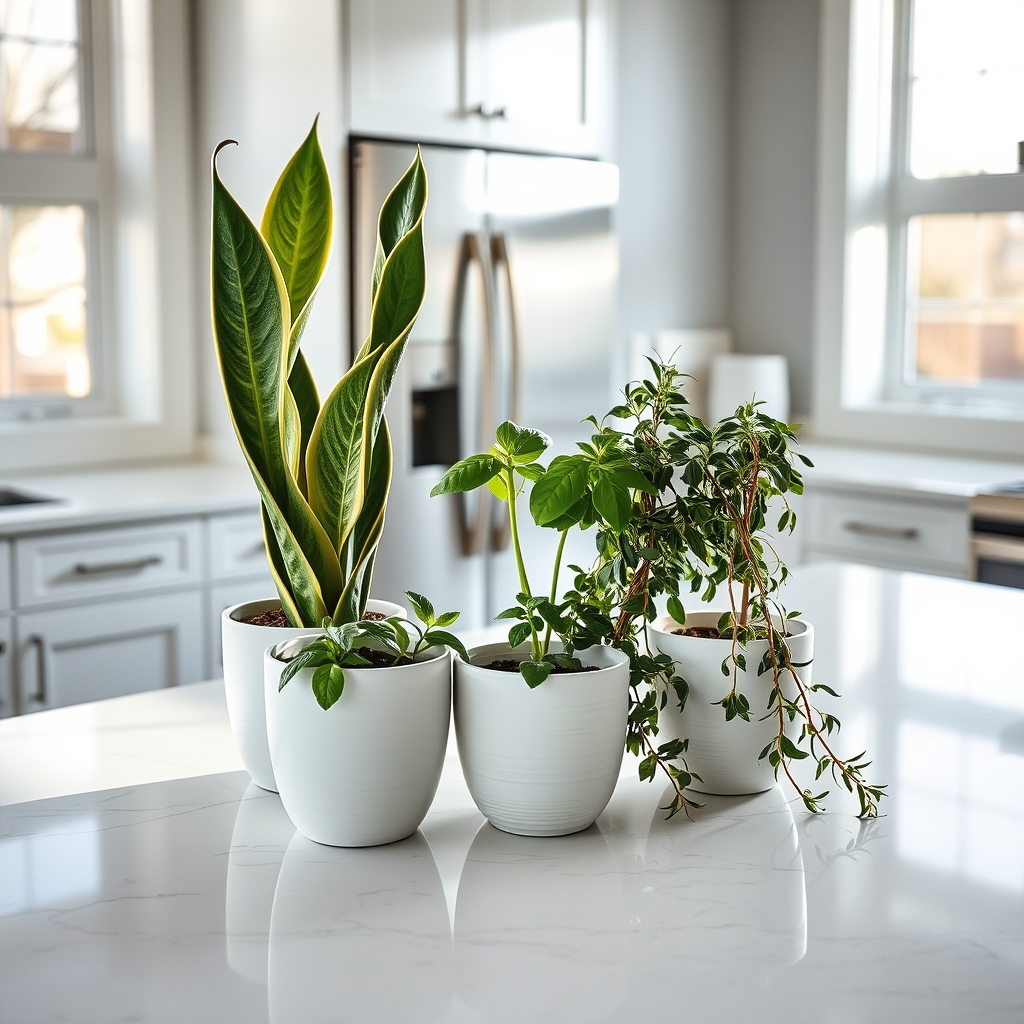
Styling Your Kitchen Island With Potted Greenery transforms a functional workspace into a vibrant focal point through strategically placed plants. Small potted herbs, succulents, or compact tropical plants occupy corners or central positions on the island without impeding food preparation areas.
The arrangement typically features varying heights and textures, with taller plants anchoring one end and smaller specimens creating visual balance. Plants sit in coordinated containers that complement the kitchen’s design, often grouped in odd numbers for aesthetic appeal.
Common choices include rosemary, basil, spider plants, or petite ferns, offering both decorative value and practical cooking benefits. The greenery softens the hard surfaces of countertops while maintaining a clean, organized appearance essential for kitchen functionality.
Incorporating Trailing Plants on Open Shelving
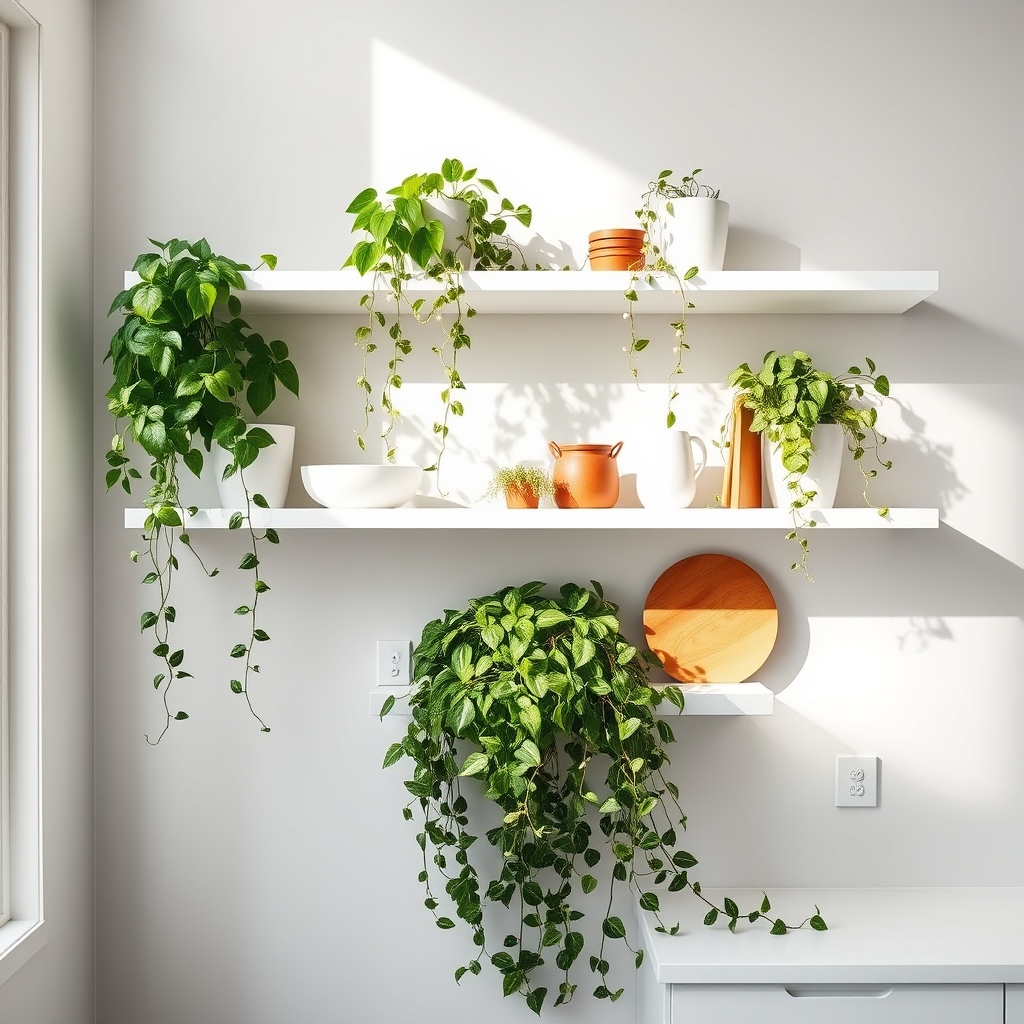
Trailing plants on open shelving create a cascading, organic display that softens rigid shelf lines while maximizing vertical space.
These plants naturally spill over shelf edges, with vines and foliage gracefully draping downward, adding movement and dimension to kitchen walls. Common choices like pothos, string of pearls, or philodendron can be positioned at varying heights, allowing their trailing stems to create natural green curtains between shelving levels.
The open shelf structure provides easy access for plant maintenance while ensuring adequate light exposure, and the combination of decorative containers with flowing greenery transforms utilitarian storage into a living display piece.
Maximizing Counter Space With Mini Succulent Gardens
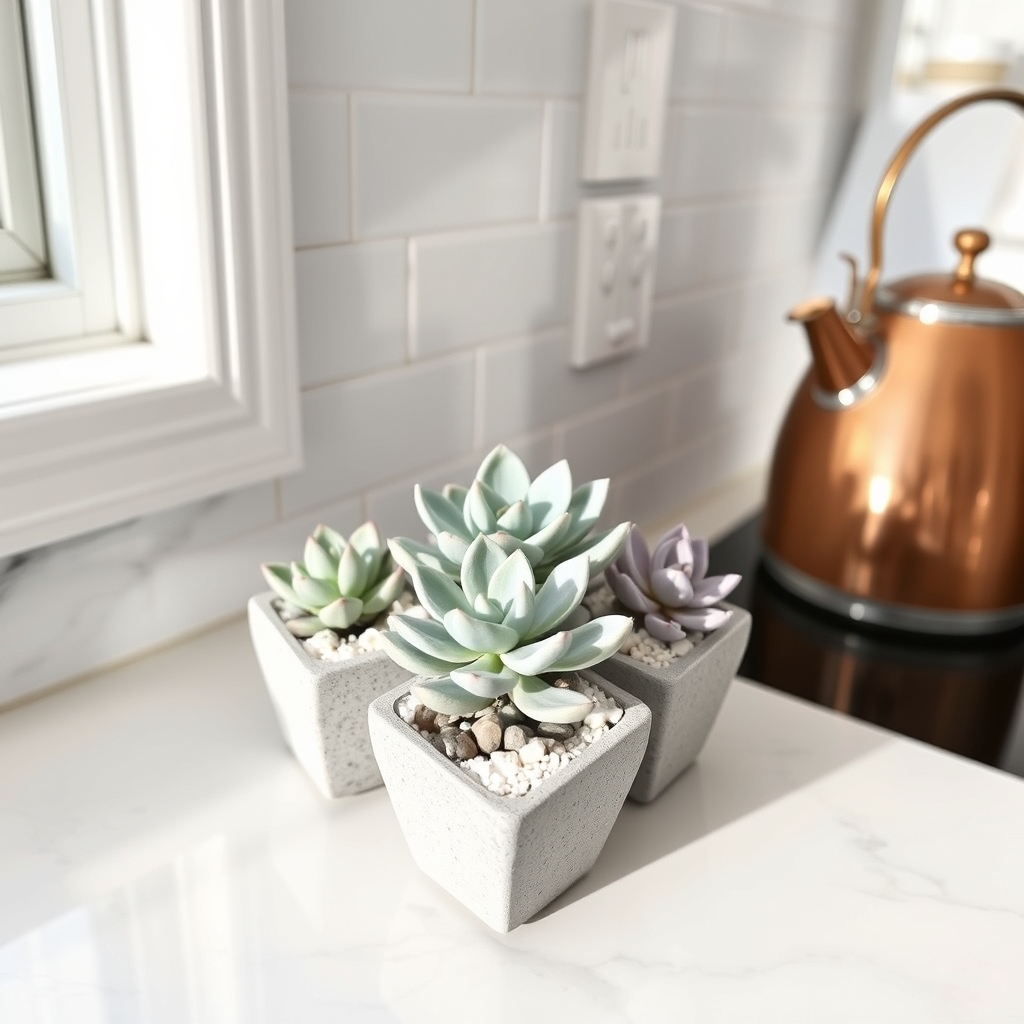
Mini succulent gardens offer an elegant solution for adding greenery to kitchen counters without sacrificing valuable workspace. These compact arrangements typically feature 3-5 small succulents planted in shallow containers no larger than 6-8 inches in diameter.
The plants are arranged in well-draining soil with decorative stones or sand, creating a low-maintenance display that sits flush against the backsplash or nestles into corner spaces.
These miniature gardens work particularly well in kitchens because succulents require minimal water and care, thrive in bright indirect light, and maintain their attractive appearance with little pruning. Their naturally compact growth pattern and variety of colors – from soft greens to purples and blues – add visual interest without overwhelming the space.
The containers can be coordinated with existing kitchen decor, using materials like concrete, ceramic, or copper to complement countertop materials and hardware finishes.
Some designs incorporate multiple small pots clustered together, allowing for easy rearrangement when counter space is needed for food preparation.
Installing Living Wall Planters for Fresh Herbs
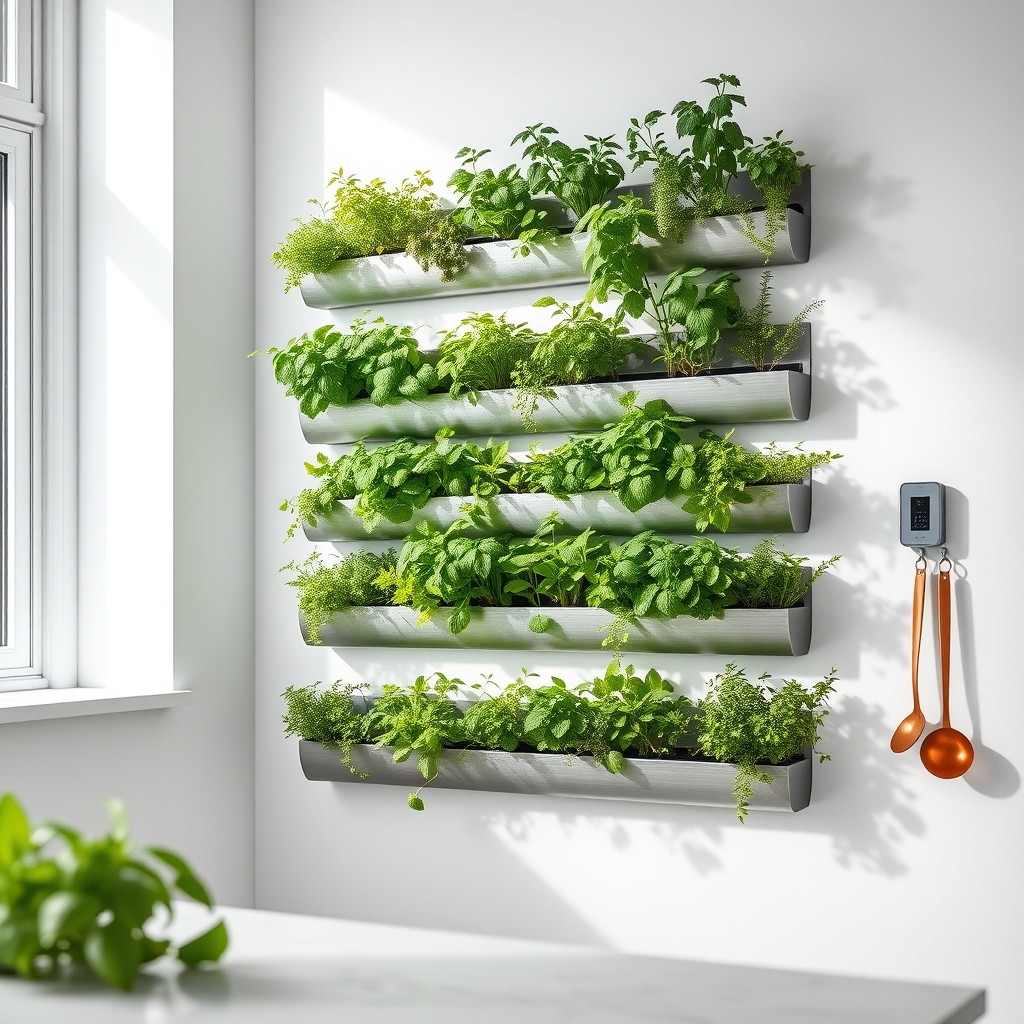
Living wall planters transform kitchen walls into functional vertical gardens specifically designed for growing fresh herbs.
These modular systems typically consist of mounted panels or individual pocket planters arranged in a grid pattern, creating a striking display of cascading greenery.
The planters can be made of various materials like recycled plastic, fabric, or metal, and often include built-in irrigation systems or self-watering features to maintain herb health.
Herbs commonly grown in these installations include basil, thyme, mint, and parsley, providing both aesthetic appeal and convenient access to fresh cooking ingredients.
The unique feature of wall planters is their space-saving design, which maximizes growing area in compact kitchens while keeping herbs within arm’s reach during food preparation.
Decorating Above Cabinets With Low-Maintenance Plants
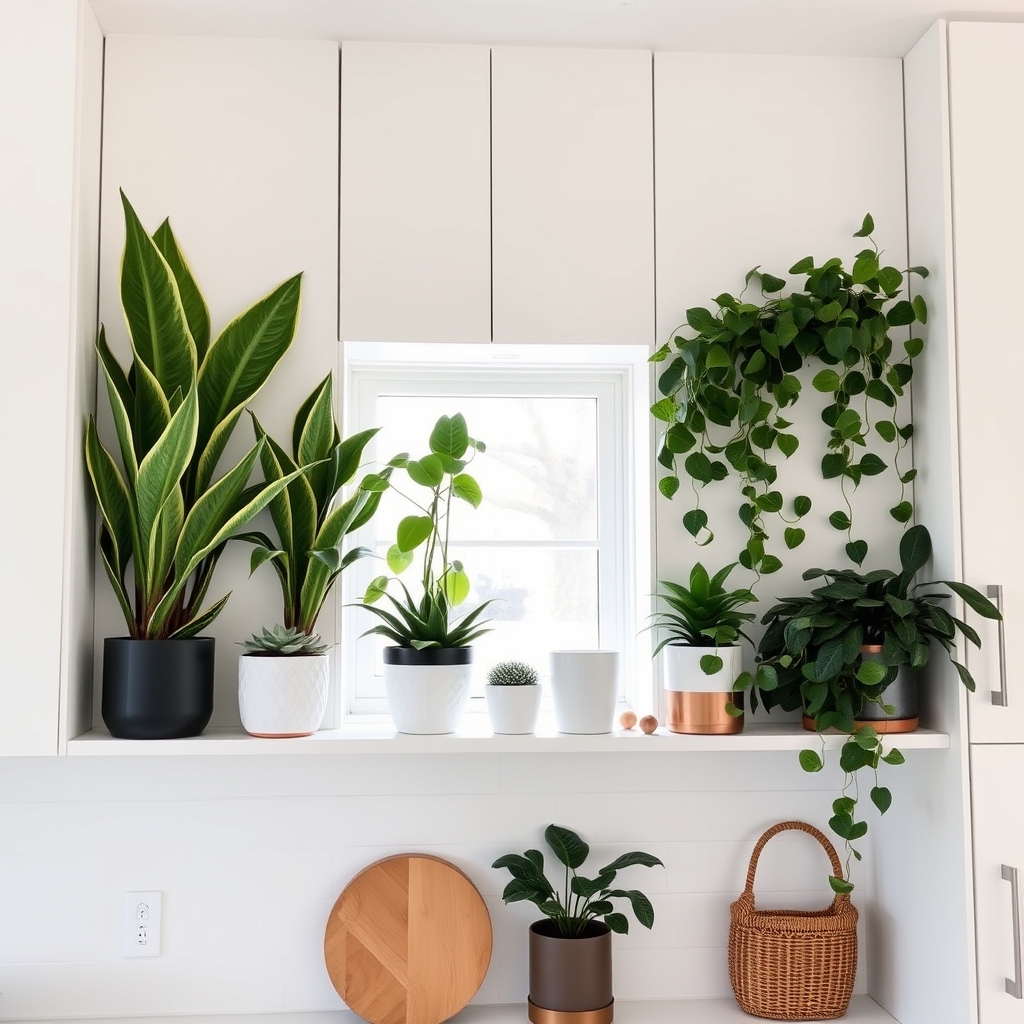
Decorating above kitchen cabinets with low-maintenance plants creates an organic, elevated display that fills empty space between cabinet tops and the ceiling. This design approach typically features drought-tolerant plants like snake plants, pothos, or artificial greenery arranged in varying heights and textures.
Plants can be placed in decorative containers, vintage pots, or sleek modern planters, often mixed with other decor elements like baskets or pottery.
Key characteristics:
- Plants are positioned safely out of food preparation areas
- Uses specimens that tolerate low light and irregular watering
- Incorporates trailing varieties that can cascade over cabinet edges
- Often combines faux and real plants for easier maintenance
- Creates visual interest in traditionally unused kitchen space
- Adds natural elements without sacrificing counter space
The arrangement’s unique feature is its ability to soften hard cabinet lines while requiring minimal care due to its elevated, out-of-the-way placement.
Setting up a Kitchen Windowsill Garden
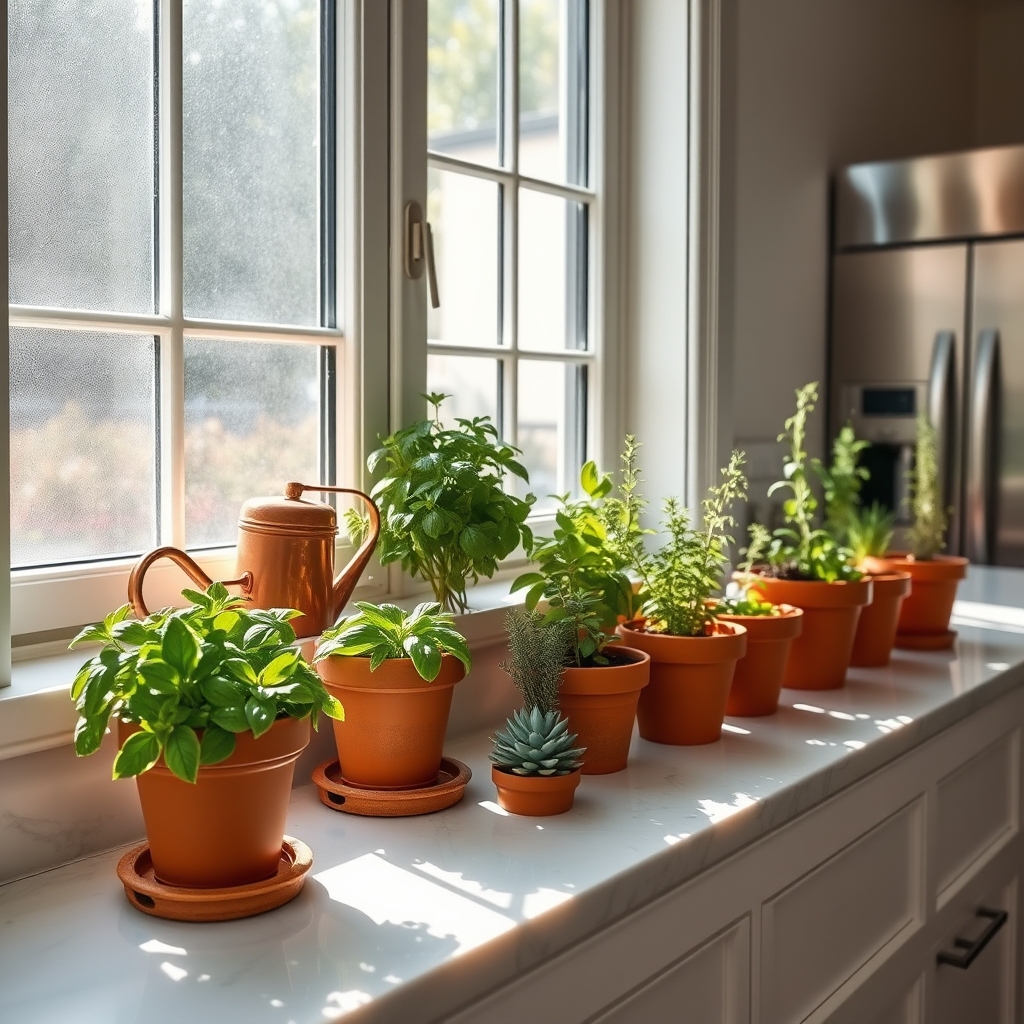
A kitchen windowsill garden transforms an ordinary window ledge into a functional growing space for herbs, small vegetables, and decorative plants.
The setup typically features a row of small pots or containers arranged along the windowsill, maximizing natural sunlight exposure.
Plants are positioned to allow proper spacing and growth, often in graduated heights with shorter plants in front and taller varieties behind.
Common elements include moisture-catching trays beneath containers, plant markers for identification, and easy-access placement for regular harvesting while cooking.
This arrangement creates a living display that combines practicality with visual appeal, bringing nature indoors while keeping fresh ingredients within arm’s reach of the cooking area.
Adding Plant-Filled Floating Shelves Above the Sink
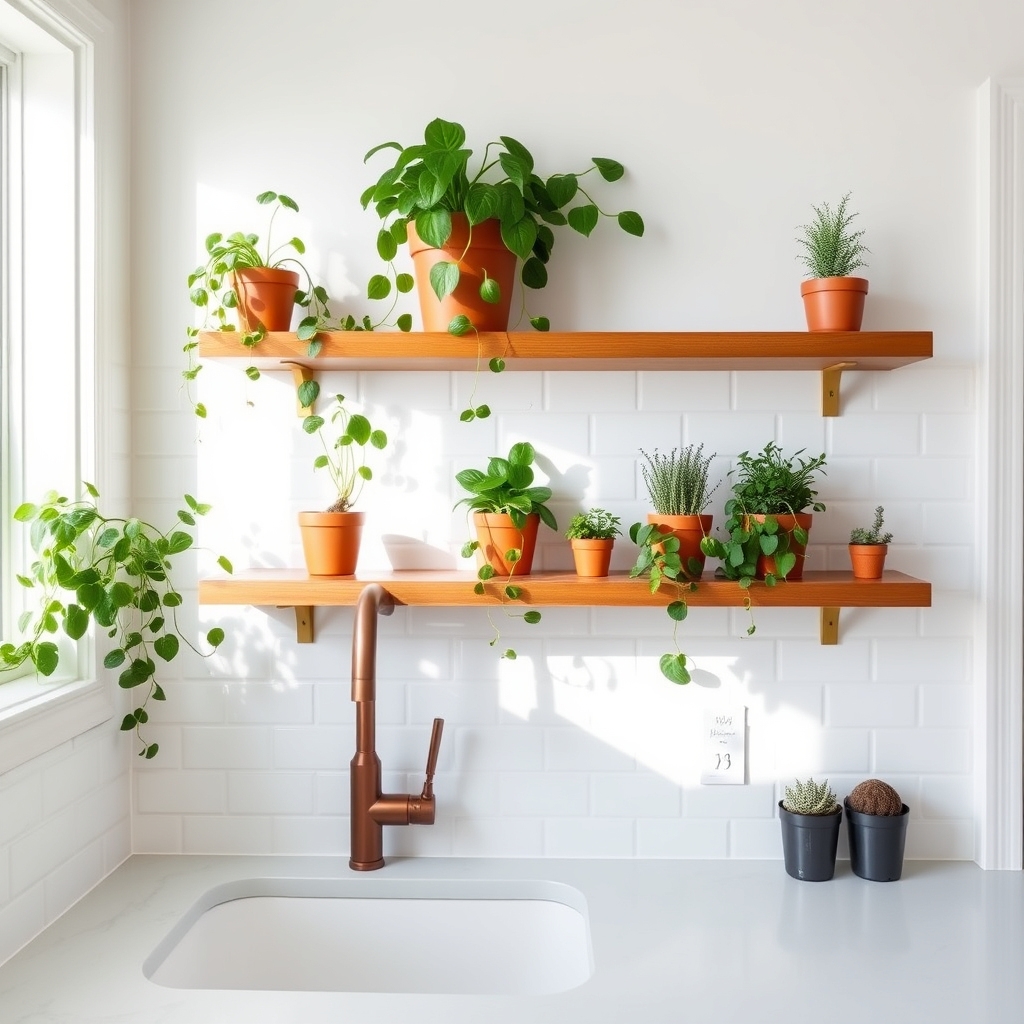
Adding plant-filled floating shelves above the sink creates a lush, layered display of greenery in an otherwise underutilized kitchen space.
Sleek, wall-mounted shelves, typically made of wood or metal, appear to float against the wall without visible brackets. These shelves can accommodate various plant sizes, from cascading pothos and ivy that drape over the edges to compact succulents and small herbs.
The arrangement adds vertical interest while keeping precious counter space clear. Plants placed here benefit from the natural humidity near the sink and often receive good indirect light from nearby windows.
The setup offers both decorative appeal and practical functionality, as herbs can be easily accessed while cooking or washing dishes.
